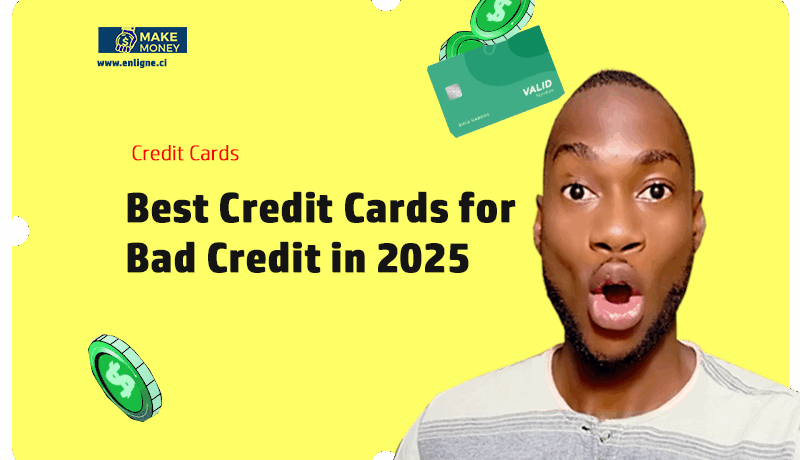
Rebuilding Your Financial Future: The Best Credit Cards for Bad Credit in June 2025
Having a “bad credit” score can feel like a significant hurdle, limiting access to essential financial products and making everyday life more challenging. However, it’s a temporary situation, and strategic use of the right credit card can be your most powerful tool to rebuild your credit health.
Table de Matière
- 1. Introduction: Turning Bad Credit into Good Credit
- Understanding “Bad Credit” and Its Impact
- Why Credit Cards Are Key to Rebuilding
- 2. Secured vs. Unsecured Credit Cards for Bad Credit
- Secured Credit Cards: The Foundation of Credit Building
- Unsecured Credit Cards for Bad Credit: Proceed with Caution
- 3. The Best Credit Cards for Bad Credit of June 2025
- Top Picks for Building Credit Safely (Secured)
- Promising Options for Building Credit (Unsecured)
- Other Notable Credit-Building Tools
- 4. Key Factors to Consider When Choosing a Card
- 5. Strategies for Rebuilding Credit Effectively
- 6. Conclusion: Your Journey to a Healthier Credit Score
1. Introduction: Turning Bad Credit into Good Credit
A low credit score, often referred to as “bad credit” (typically FICO scores below 580), can limit your financial opportunities. It might mean higher interest rates on loans, difficulty renting an apartment, or even challenges with employment. However, it’s crucial to understand that bad credit is not a life sentence. It’s a signal that past financial choices have impacted your score, but with strategic action, you can absolutely improve it.
Understanding “Bad Credit” and Its Impact
Your credit score is a numerical representation of your creditworthiness. Factors like payment history, amounts owed, length of credit history, new credit, and credit mix all contribute. Bad credit often stems from missed payments, defaults, bankruptcies, or a lack of credit history. Lenders view low scores as higher risk, leading to fewer approvals or less favorable terms.
Why Credit Cards Are Key to Rebuilding
Credit cards, when used responsibly, are one of the most effective tools for credit repair. They allow you to:
- Establish a Payment History: Consistently paying your credit card bill on time is the single most important factor in improving your score.
- Demonstrate Responsible Usage: Keeping your credit utilization (how much credit you use versus your total available credit) low shows you can manage credit wisely.
- Build Credit History: Over time, a positive credit card account adds length and depth to your credit report.
2. Secured vs. Unsecured Credit Cards for Bad Credit
When you have bad credit, your options are primarily split into two categories: secured and certain types of unsecured credit cards.
Secured Credit Cards: The Foundation of Credit Building
A secured credit card requires you to put down a refundable cash deposit, which typically becomes your credit limit. For example, a $200 deposit usually means a $200 credit limit.
- How they work: The deposit acts as collateral, reducing the risk for the lender. You use the card like any other credit card, making purchases and paying your bill.
- Key benefit: Your payment activity is reported to the major credit bureaus, allowing you to build positive payment history.
- Path to Graduation: Many secured cards offer a path to “graduate” to an unsecured card and get your deposit back after a period of responsible use.
Unsecured Credit Cards for Bad Credit: Proceed with Caution
An unsecured credit card does not require a deposit. While seemingly more attractive, cards offered to individuals with bad credit often come with:
- Higher Fees: Annual fees, monthly maintenance fees, or even one-time program fees can quickly erode any benefit.
- Lower Credit Limits: Initial limits are often very small.
- High APRs: Interest rates are typically very high, making it costly to carry a balance.
- Subprime Offerings: Some are predatory, with excessive fees. It’s crucial to choose wisely.
3. The Best Credit Cards for Bad Credit of June 2025
Based on their features for credit building, fee structures, and pathways to better credit, here are some of the top credit cards recommended for those with bad credit:
Top Picks for Building Credit Safely (Secured)
These cards are highly recommended because they report to credit bureaus, have manageable fees, and offer a clear path to improving your score.
- Discover it® Secured Credit Card:
- Why it’s best: Stands out for offering cash back rewards (1% on all purchases, 2% at gas stations and restaurants on up to $1,000 in combined purchases each quarter), which is rare for secured cards. It also features automatic reviews to transition to an unsecured card.
- Deposit: Minimum $200.
- Annual Fee: $0.
- Capital One Platinum Secured Credit Card:
- Why it’s best: Known for its flexible deposit options, allowing some applicants to get a $200 credit line for a deposit as low as $49, $99, or $200, based on creditworthiness. Offers automatic credit limit reviews.
- Deposit: Starts at $49 for a $200 credit line.
- Annual Fee: $0.
- OpenSky® Secured Visa® Credit Card:
- Why it’s best: A great option for those who may not qualify for other cards as it doesn’t require a credit check to apply. Your approval is based on your ability to make the security deposit.
- Deposit: Minimum $200.
- Annual Fee: Modest annual fee (e.g., $35).
- Chime Credit Builder Secured Visa® Credit Card:
- Why it’s best: Integrates with a Chime Checking Account. It has no annual fee, no interest, and no credit check. Funds moved from your Chime Checking Account to your Credit Builder Secured Account are used as your credit limit. Safe way to build credit without debt.
- Deposit: No minimum deposit required, your spending limit is based on what you move from your Chime Checking Account.
- Annual Fee: $0.
Promising Options for Building Credit (Unsecured)
These unsecured cards for bad credit should be approached with caution regarding fees, but some offer reasonable terms for those seeking to avoid a deposit.
- Petal® 1 Visa® Credit Card:
- Why it’s best: Unsecured with no annual fee (for most applicants). Petal uses its “Cash Score” technology to evaluate creditworthiness beyond traditional credit scores, looking at banking history, which can benefit those with thin or bad credit.
- Annual Fee: $0 or potentially a low annual fee ($59) depending on approval.
- Mission Lane Visa® Credit Card:
- Why it’s best: Offers a prequalification tool that doesn’t impact your credit score. It has a reasonable annual fee and aims to provide a path to a higher credit limit.
- Annual Fee: Varies, but generally moderate (e.g., $59-$75).
- Avant Credit Card:
- Why it’s best: An unsecured option that caters to individuals with fair to poor credit. It provides relatively quick access to a credit line and can help those who are just starting to improve their scores.
- Annual Fee: May have an annual fee, variable based on creditworthiness.
- Prosper® Card:
- Why it’s best: Designed for those building credit and may offer immediate access to 50% of your credit limit upon approval, which can be useful for urgent needs. It typically offers a waived annual fee for the first year with autopay.
- Annual Fee: Varies, but can be waived for the first year.
Other Notable Credit-Building Tools
While potentially having higher fees or more specific use cases, these cards also serve the purpose of helping to build credit:
- Credit One Bank® Cards (Various Offerings):
- Key Features: Credit One Bank offers various unsecured cards for bad credit, often with cash back rewards. However, they frequently come with annual fees, monthly maintenance fees, and high APRs, which must be carefully considered.
- Ideal For: Those who absolutely need an unsecured card and can manage fees meticulously to avoid falling further into debt.
- Indigo® Platinum Mastercard®:
- Key Features: An unsecured option that pre-qualifies applicants with less-than-perfect credit without a hard credit check. Approval is often possible even with past bankruptcies.
- Annual Fee: Varies, can be $0 up to $99.
- Reflex® Platinum Mastercard®:
- Key Features: Another unsecured card for rebuilding credit that offers pre-qualification and generally reports to all three major credit bureaus.
- Annual Fee: Varies, can be $75-$125.
4. Key Factors to Consider When Choosing a Card
Selecting the best credit card for bad credit requires careful evaluation:
- Annual Fees: This is the most common fee. A $0 annual fee card is ideal, but a small fee might be acceptable if the card offers other strong credit-building features. Beware of cards with high annual fees or additional monthly maintenance fees.
- Security Deposits: For secured cards, ensure the deposit is affordable and that the card offers a clear path to convert to an unsecured card and get your deposit back.
- Reporting to Credit Bureaus: This is NON-NEGOTIABLE. The card must report your payment activity to all three major credit bureaus (Experian, Equifax, and TransUnion) for your responsible use to impact your score.
- Path to Unsecured/Higher Limits: Look for cards that promise periodic reviews for credit limit increases or a “graduation” to an unsecured card. This indicates the issuer supports your credit-building journey.
- APR and Other Fees: While you should aim to pay your balance in full to avoid interest, understand the APR. Also, check for late payment fees, returned payment fees, and foreign transaction fees.
5. Strategies for Rebuilding Credit Effectively
Getting the right card is just the first step. Consistent, responsible behavior is what truly builds credit.
- Pay Your Bills On Time, Every Time: This is the single most important factor (35% of your FICO score). Set up autopay or reminders.
- Keep Your Credit Utilization Low: Aim to keep your balance below 30% of your credit limit, ideally below 10%. If your limit is $200, try not to spend more than $60-$20.
- Avoid Applying for Too Much Credit: Each application can cause a small, temporary dip in your score. Only apply for cards you genuinely need and are likely to get approved for.
- Monitor Your Credit Score Regularly: Use free tools (like those offered by credit card issuers or credit monitoring services) to track your progress and spot any errors.
6. Conclusion: Your Journey to a Healthier Credit Score
Having bad credit is a challenge, but it’s a challenge you can overcome with the right tools and habits. The credit cards listed above offer a solid foundation for rebuilding. By understanding their features, making smart choices, and practicing consistent financial discipline, you can steadily improve your credit score, unlock better financial opportunities, and secure your financial future.
Start your journey today by exploring the best options for your unique situation.






No Comment! Be the first one.